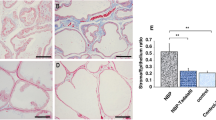Abstract
Tadalafil (TAD) is primarily a treatment drug for erectile dysfunction. Studies have shown that TAD has a therapeutic effect on prostatitis, but the specific mechanism has not been reported. LPS induced RWPE-1 cells to form a model of chronic nonbacterial prostatitis (CNP). Cell activity was measured by MTT assay. Apoptosis was detected by TUNEL assay. Western blot was used to detect the expression of apoptosis-related proteins Bcl-2, Bax, Caspase-3, and cleaved caspase3. ELISA was used to detect the expression of inflammatory cytokines TNF-α, IL-6, and IL-8. GSH, catalase (CAT), and malondialdehyde (MDA) kits were used to detect the expression of oxidative stress–related indicators GSH, CAT, and MDA. Western blot was used to detect the expression of proteins related to Akt/Nrf2 signaling pathway. After different concentrations of TAD were given, the survival rate of LPS-induced RWPE-1 cells decreased, apoptosis increased, and inflammation and oxidative stress decreased. This process is accompanied by the activation of the Akt/Nrf2 signaling pathway. The addition of AKT inhibitor (HY-10249A) reversed the inhibitory effect of TAD on LPS-induced inflammatory response and oxidative stress of RWPE-1 cell. TAD alleviated LPS-induced inflammation and oxidative stress of RWPE-1 cell by regulating the Akt/Nrf2 signaling pathway.







Similar content being viewed by others
Data Availability
The analyzed data sets generated during the present study are available from the corresponding author on reasonable request.
References
Abdel-Meguid, T.A., H.A. Mosli, H. Farsi, A. Alsayyad, A. Tayib, M. Sait, and A. Abdelsalam. 2018. Treatment of refractory category III nonbacterial chronic prostatitis/chronic pelvic pain syndrome with intraprostatic injection of onabotulinumtoxinA: a prospective controlled study. The Canadian Journal of Urology 25 (2): 9273–9280.
Polackwich, A.S., and D.A. Shoskes. 2016. Chronic prostatitis/chronic pelvic pain syndrome: a review of evaluation and therapy. Prostate Cancer and Prostatic Diseases 19 (2): 132–138.
Paulis, G. 2018. Inflammatory mechanisms and oxidative stress in prostatitis: the possible role of antioxidant therapy. Res Rep Urol 10: 75–87.
Shimizu, S., Y. Nagao, T. Kataoka, S. Kamada, T. Shimizu, Y. Higashi, and M. Saito. 2020. Protective effects of tadalafil on prostatic hyperplasia in spontaneously hypertensive rats. European Journal of Pharmacology 882: 173313.
Hiramatsu, I., A. Tsujimura, M. Soejima, A. Yoshiyama, Y. Nagashima, K. Ishikawa, Y. Uesaka, T. Nozaki, T. Ogishima, M. Shirai, I. Mitsuhashi, S. Sugimura, T. Mizuno, K. Noto, Y. Shigeta, J. Takasu, S. Honda, S. Iwata, and S. Horie. 2020. Tadalafil is sufficiently effective for severe chronic prostatitis/chronic pelvic pain syndrome in patients with benign prostatic hyperplasia. International Journal of Urology 27 (1): 53–57.
Dearakhshandeh, N., A. Mogheiseh, S. Nazifi, M.S. Ahrari Khafi, M. Abbaszadeh Hasiri, and K. Golchin-Rad. 2019. Changes in the oxidative stress factors and inflammatory proteins following the treatment of BPH-induced dogs with an anti-proliferative agent called tadalafil. Journal of Veterinary Pharmacology and Therapeutics 42 (6): 665–672.
Sugimoto, M., X. Zhang, N. Ueda, H. Tsunemori, R. Taoka, Y. Hayashida, H. Hirama, Y. Miyauchi, Y. Matsuoka, H. Naito, Y. Osaki, and Y. Kekehi. 2019. A phosphodiesterase 5 inhibitor, tadalafil, suppresses stromal predominance and inflammation in a rat model of nonbacterial prostatitis. BMC Urology 19 (1): 99.
Ogihara, T., T. Nakagawa, M. Hayashi, M. Koyanagi, A. Yonezawa, T. Omura, S. Nakagawa, N. Kitada, S. Imai, and K. Matsubara. 2019. Improvement of peripheral vascular impairment by a phosphodiesterase type 5 inhibitor tadalafil prevents oxaliplatin-induced peripheral neuropathy in mice. Journal of Pharmacological Sciences 141 (4): 131–138.
Yamamura, A., E. Fujitomi, N. Ohara, K. Tsukamoto, M. Sato, and H. Yamamura. 2017. Tadalafil induces antiproliferation, apoptosis, and phosphodiesterase type 5 downregulation in idiopathic pulmonary arterial hypertension in vitro. European Journal of Pharmacology 810: 44–50.
Lee, H.J., D. Feliers, M.M. Mariappan, K. Sataranatarajan, G.G. Choudhury, Y. Gorin, and B.S. Kasinath. 2015. Tadalafil integrates nitric oxide-hydrogen sulfide signaling to inhibit high glucose-induced matrix protein synthesis in podocytes. The Journal of Biological Chemistry 290 (19): 12014–12026.
Dos Santos Gomes, F.O., et al. 2018. Intraurethral injection with LPS: an effective experimental model of prostatic inflammation. Inflammation Research 67 (1): 43–55.
Locatelli, M., et al. 2018. Graminex pollen: phenolic pattern, colorimetric analysis and protective effects in immortalized prostate cells (PC3) and rat prostate challenged with LPS. Molecules (5): 23.
Xu, X., J. Hou, J. Lv, Y. Huang, J. Pu, and L. Wang. 2019. Overexpression of lncRNA GAS5 suppresses prostatic epithelial cell proliferation by regulating COX-2 in chronic non-bacterial prostatitis. Cell Cycle 18 (9): 923–931.
Smothers, A., S. Young, and L. Constantine. 2020. Management of chronic nonbacterial prostatitis and chronic pelvic pain syndrome in the adult male patient with comorbid conditions. Journal of Christian Nursing 37 (3): E21–E26.
Xuanfei, L., C. Hao, Y. Zhujun, L. Yanming, and G. Jianping. 2017. Imidazoline I2 receptor inhibitor idazoxan regulates the progression of hepatic fibrosis via Akt-Nrf2-Smad2/3 signaling pathway. Oncotarget 8 (13): 21015–21030.
Rizvi, F., A. Mathur, and P. Kakkar. 2015. Morin mitigates acetaminophen-induced liver injury by potentiating Nrf2 regulated survival mechanism through molecular intervention in PHLPP2-Akt-Gsk3beta axis. Apoptosis 20 (10): 1296–1306.
Abdel-Wahab, B.A., S.A. Alkahtani, and E.A.M. Elagab. 2020. Tadalafil alleviates cisplatin-induced reproductive toxicity through the activation of the Nrf2/HO-1 pathway and the inhibition of oxidative stress and apoptosis in male rats. Reproductive Toxicology 96: 165–174.
Author information
Authors and Affiliations
Corresponding author
Ethics declarations
Competing Interests
The authors declare that they have no competing interests.
Ethics Approval and Consent to Participate
Not applicable.
Patients Consent for Publication
Not applicable.
Additional information
Publisher’s Note
Springer Nature remains neutral with regard to jurisdictional claims in published maps and institutional affiliations.
Rights and permissions
About this article
Cite this article
Song, X., Chen, G., Li, C. et al. Tadalafil Alleviates LPS-Induced Inflammation and Oxidative Stress of RWPE-1 Cell by Regulating the Akt/Nrf2 Signaling Pathway. Inflammation 44, 890–898 (2021). https://doi.org/10.1007/s10753-020-01384-w
Received:
Revised:
Accepted:
Published:
Issue Date:
DOI: https://doi.org/10.1007/s10753-020-01384-w




